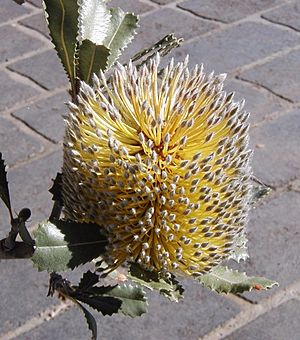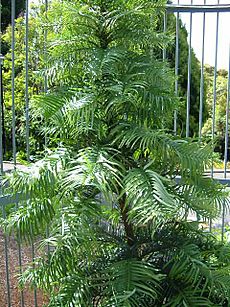Australian Botanic Garden Mount Annan facts for kids
Quick facts for kids Australian Botanic Garden Mount Annan |
|
|---|---|

Banksia ornata, next to Gardens entrance
|
|
| Lua error in Module:Location_map at line 420: attempt to index field 'wikibase' (a nil value). | |
| Location | Mount Annan, southwestern Sydney, New South Wales, Australian |
| Area | 416 hectares (1,030 acres) |
| Operated by | The Botanic Gardens Trust trading the Botanic Gardens & Centennial Parklands |
| Visitors | 400,000 (in 2016) |
| Status | Open all year |
The Australian Botanic Garden Mount Annan is a huge plant paradise. It covers about 416 hectares (that's like 1,000 football fields!). You can find it in a hilly part of Mount Annan, a suburb in southwestern Sydney, New South Wales.
This garden is special because it's the biggest botanical garden in Australia. It focuses on native Australian plants. You can see over 4,000 different kinds of plants here! The garden first opened in 1988. It was known as Mount Annan Botanic Garden until 2011.
Contents
History and Management
Long ago, the Dharawal people were the first caretakers of this land. They are Indigenous Australians.
Later, the land was used for dairy farming. In 1984, the Royal Botanic Gardens and Domain Trust bought the land. The garden officially opened to the public in 1988. Sarah Ferguson, a member of the British Royal Family, opened it.
The garden is managed by the Botanic Gardens Trust. This group also looks after the Royal Botanic Garden, Sydney and the Blue Mountains Botanic Garden. In 2011, the garden's name changed to The Australian Botanic Garden, Mount Annan.
Since 2014, the garden has held a special event called the "Save a Species Walk." This walk helps raise money to protect rare and endangered plants.
Exploring the Garden
The Australian Botanic Garden is a mix of natural Australian bushland and special plant displays. It's a great place to learn about Australian plants. You can also enjoy picnics and walk on over 20 kilometers of tracks.
The garden is also home to a research center for native plants. It has the NSW PlantBank, which is very important for plant conservation.
Some of the cool places to visit in the garden include:
- Woodland Conservation Area
- Woodland Picnic Area
- Stolen Generations Memorial
- The Australian PlantBank
- Visitor Centre, Cafe & Playground
- Lakeside Lawn
- Connections Garden
- Fig Tree Wedding Arboretum & Knot
- Sundial of Human Involvement
- Wollemi Discovery Walk
- Big Idea Garden
- Mountain Bike Trail
- Wattle Garden
- Banksia Garden
- Callitris Grove
- Kurrajong Arboretum
- Mallee Eucalypts
- The Blue Tree
The Woodland Picnic Area protects a special type of forest called Cumberland Plain Woodland. This forest is endangered. The garden is also a safe home for over 160 types of birds. You might even spot wallaroos, wallabies, and kangaroos! It's an important place for local wildlife.
The garden is very large. You can drive on two loop roads to get around. But to truly see its beauty, you should stop and walk through the different garden areas. From the top of Sundial Hill, you get amazing 360-degree views. You can even see the Sydney skyline!
Over the years, the garden has changed a lot. For example, the old Terrace Garden is now the Connections Garden. It's a beautiful part of the garden.
The SeedBank and PlantBank
The SeedBank started in 1986. Its first job was to collect seeds from the wild. These seeds helped grow the new garden, especially its collections of wattles, eucalypts, and protea plants.
Today, the SeedBank still helps the garden grow. But it also plays a big part in saving plants and doing research around the world.
A new, important building called the PlantBank opened in 2013. It was opened by Professor Marie Bashir, who was the Governor of New South Wales at the time. The PlantBank helps store and research plant seeds for the future.
The Amazing Wollemi Pine
The garden helps protect special plants like the endangered Wollemi Pine. This tree was discovered in 1994. It was found in the Wollemi National Park, about 200 kilometers northwest of Sydney. Before this, people thought the Wollemi Pine was extinct! They only knew about it from old fossils.
Finding this tree was a huge discovery for plant scientists. The first Wollemi Pines were grown at Mount Annan in 1995. These trees were so rare and valuable that they were grown inside strong steel cages to protect them from thieves!
Now, the Australian Botanic Garden has a special place called the Wollemi Walk of Discovery. Here, you can see the only publicly available collection of these "first generation" Wollemi Pines. The Walk opened in 2006 and has sixty of these rare trees.
Lakes and Weather Station
The garden has five main lakes. Lake Gilinganadum and Lake Nadungamba are in the northern part. Lake Sedgwick and Lake Fitzpatrick are in the middle. The Wattle Garden lake is in the south. There are also three smaller lakes.
Near Lake Nadungamba, you can find the Campbelltown Weather station. It's run by the Bureau of Meteorology.
Macarthur Centre for Sustainable Living
At the northern end of the garden is the Macarthur Centre for Sustainable Living. This center teaches people how to live in a way that helps the environment. It shows how to garden organically.
The center has a large community garden. People who don't have space at home can grow their own vegetables and plants here. The center wants to promote living in a way that is good for everyone and the planet. It shows how to save energy and water, and how to manage waste.
Activities
- Guided tours to learn more about the plants
- Walks and scenic views for exploring
- Bird-watching, including a special bird hide near Lake Nadungamba
- A dedicated mountain bike area with trails for different skill levels
- Picnic shelters with barbecue facilities
- Café and visitor centre for food and information
Images for kids
See also
 In Spanish: Jardín botánico Monte Annan para niños
In Spanish: Jardín botánico Monte Annan para niños




